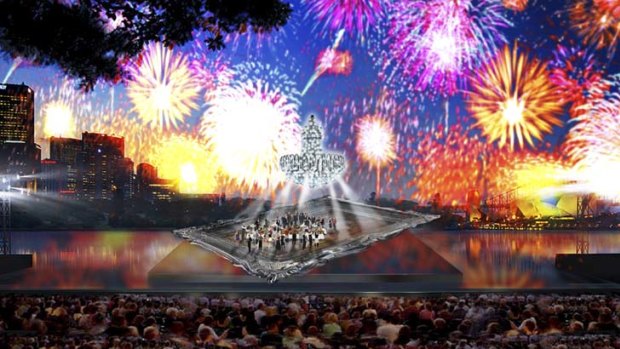Next March, soprano Rachelle Durkin will have to sing one of opera's most technically challenging roles while she is suspended in a glass cage attached to a huge chandelier hanging high above a tilted stage on Sydney Harbour. Fireworks will be exploding around her.
The success of any performance of Verdi's famous opera about a ''fallen woman'' who finds love too late rests heavily on the performance of the soprano in La Traviata's title role. Violetta's aria ''Sempre Libera'' at the end of Act 1, with its 20 high Cs, has been sung by many great sopranos since its premiere in 1853. But none had to do it like this.

High note … artists' impressions for La Traviata show the stage.
Durkin shares the role with Emma Matthews for the three-week run next March - the first of three operas to be staged on Sydney Harbour by Opera Australia. Durkin says her preparation won't be any different from other operas ''but physically I suspect it will be more demanding''.
The cast will perform on a 24-metre deep and 32-metre wide stage; they will have to get used to being miked, and they may have to contend with wind and rain. ''I admit, I have butterflies already. There will be many technical rehearsals I'm sure, but its certainly not without its challenges … perhaps some extra-hold hair spray and waterproof mascara won't go astray,'' Durkin jokes.
But the challenges facing the cast are just the half of it.
Opera Australia artistic director Lyndon Terracini's grand plan to appeal to a much broader audience with spectacular outdoor productions is no easy feat.
Preparations underway since March this year have included negotiations with a range of government agencies for permission to use the Botanic Gardens and the harbour for the production; with pylon and scaffolding companies that will help build the stage and a 3000-seat amphitheatre (almost double the capacity of the one used by the OpenAir Cinema); with the City of Sydney, which must approve the development application; and with aborists to make sure no damage is done to trees and roots in the gardens.
Tidal charts have been consulted to make sure the purpose-built stage will remain above the water line even in the face of the biggest king tide; extra days have been added to the performance schedule in case of rain, and a matrix of weather scenarios mapped out. In the case of high winds, small changes to the performances will be made for safety reasons.
The production's executive producer, Louisa Robertson, has always been sure they could pull it off.
''It is a challenge but I have never thought it wouldn't work,'' she tells the Herald at Opera Australia's Surry Hills office, surrounded by drawings and diagrams of the stage and seating. ''It will work. We have an amazing team of people.''
Her own experience as executive producer of the Brisbane Festival for six years and senior producer of the Queensland Music Festival for three has prepared her for the mammoth task of negotiating with engineers, set designers, builders and Opera Australia staff while keeping the $12 million project on budget.
''In terms of dollars, it is similar to putting on an entire festival but it is all at one venue and it is a lot more complicated,'' she says.
Just one of the challenges facing the La Traviata team was how to build the amphitheatre on a site at Fleet Steps without damaging the trees. Damage to their roots or canopies could stunt their growth.
Site designer Ross Wallace turned a negative into a positive by incorporating the trees into the VIP lounge. A laser scan was taken of the trees then decking and dining areas built around them.
''The top layer of the VIP area merges into the canopy, the trees will be festooned with twinkling lights and some of the trees will be illuminated from below in cobalt blue,'' says Wallace. The trees have become part of the ''magical forest'' atmosphere, including camellia and chandelier motifs sprinkled through the dining and bar areas. Wallace hopes the designs will conjure up images of 19th-century Parisian salons and parties.
That almost seems simple compared with erecting a stage on water. Set back 29m from the shore, the stage - which includes a base structure and raked scaffolding, and an orchestra pit, dressing rooms and toilets underneath - will be supported by nine pylons sunk into the harbour. Another three pylons will support a walkway running from the stage to the shore, and two more under each of the 16.5m-high sound and lighting towers.
But there's more. A 250-tonne crane will be hired to lift a second, smaller crane onto the stage. Suspended from that crane will be a 3.5-tonne, 9m chandelier, adorned with 10,000 Swarovski crystals. The chandelier will be raised and lowered at various times during the performance, unless it is too windy - then producers will cut to a ''plan B'' storyline, sans chandelier.
Engineers are still tinkering with exactly how they will raise and lower a 9m Chesterfield onto the stage. An exclusion zone will be set around the stage to minimise wash from other boats on the harbour but getting cast members out of small boats and up on to a stage that will sit higher in the water some nights than others is another problem yet to be solved.
One of the producers' most unexpected dilemmas was finding a rehearsal space big enough to accommodate the opera. Only the Hall of Legends at Sydney Olympic Park proved suitable.
It's no surprise to learn that none of this comes cheaply. A sponsorship by Japanese businessman and philanthropist Dr Haruhisa Handa plus investment by Destination NSW have helped ease the financial pain.
Opera On the Harbour will be performed at Mrs Macquarie's Point from March 24 to April 15. Details at operaonsydneyharbour.com.au.